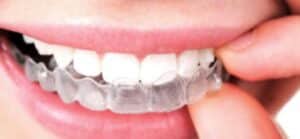
Orthodontic treatment is frequently used to help improve the bite, jaw position, and tooth alignment. Braces with visible wires and brackets were once the only option, but now there are alternatives.
Individuals self-conscious about their smile and want to avoid traditional metal braces now have alternative treatment options. Big Smile Dental provides Invisalign treatments to our patients from all areas of Chicago.
Invisalign provides invisible orthodontia (with invisible aligners) that can be as effective as traditional braces. The clear aligner trays provide softer pressure, making them more comfortable to wear than traditional metal braces. These aligners eliminate the complexity and discomfort of brackets and wires, resulting in nearly unnoticeable orthodontic care.
With the average cost of Invisalign ranging from $3,000 to $7,000, you may wonder if you can afford the smile you desire without draining your savings. This article aims to help you understand the breakdown and factors that influence treatment costs and ways to make your treatment more affordable.
What Is Invisalign?
Invisalign employs custom-made plastic aligners (aligner trays) manufactured using molds from your mouth. These removable aligners are solid pieces of plastic that apply enough pressure on specific parts of your teeth to move them into their ideal position. For optimal results, Invisalign must be worn 20 to 22 hours each day.
The advantages of removable Invisalign braces over traditional braces are numerous. The most significant advantage is its aesthetic attractiveness during the process. Additionally, removable Invisalign braces are less abrasive than metal ones. Patients are less sensitive to oral cuts and abrasions, often caused by sharp metal fragments. Similarly, you can avoid the formation of gingivitis, which can result from plaque accumulation. Most patients who wear braces struggle to maintain appropriate dental hygiene. This difficulty is eliminated by Invisalign’s ability to be removed and replaced.
During your initial consultation with us, we will evaluate your teeth and oral health and take impressions of your mouth. Depending on your evaluation, we will create a comprehensive treatment plan to achieve your desired outcome.
What Can Invisalign Treat?
During your initial consultation, we will take x-rays to evaluate your oral health and determine your eligibility for this form of treatment. A full Invisalign treatment can correct conditions such as:
In addition, we may schedule follow-up appointments to ensure no difficulties or concerns arise due to the veneer placement. In most cases, however, three appointments should suffice to complete the procedure.
How Much Does Invisalign Cost?
The severity of your condition and the length of treatment are the primary factors influencing your aligner treatment costs. Depending on your age and orthodontic needs, you have several treatment options:
Mild corrections:
Mild to moderate corrections:
Moderate to severe corrections:
Invisalign for teens:
More severe cases may require the full comprehensive treatment package. Therefore, average costs may range from $3,000 to $7,000.
Factors Influencing the Cost of Invisalign
Several factors contribute to the cost of Invisalign, including:
In addition, the amount of coverage provided by your insurance plan will be incorporated into the total cost of therapy.
How Much Is Invisalign With Insurance?
Most preferred provider organization (PPO) dental insurance plans cover Invisalign. Most dental insurance providers will cover a portion of your total cost if your treatment plan includes this benefit since orthodontia insurance coverage is limited. Our team will gladly contact your dental insurance provider on your behalf, so you can focus on getting the smile of your dreams.
Because Invisalign is classified as orthodontic dental treatment, approximately 25% of Invisalign patients receive insurance reimbursement of more than $500 on average. However, most have a maximum amount they are willing to pay, which ranges from $1,500 to $2,000. As such, the percentage varies depending on the total cost of your treatment.
Big Smile Dental works hard to keep Invisalign procedures in Chicago inexpensive. You might be able to use your insurance, pay using tax-free money from your FSA or HSA, or set up a monthly payment plan.
Payment Options for Invisalign
There are several ways you can pay for Invisalign. These options include:
Therefore, the price of having a beautiful smile does not need to break your budget by opting for options that cover your orthodontic treatment.
If you want more information about Invisalign, please contact us at Big Smile Dental. We will be delighted to arrange a consultation.





